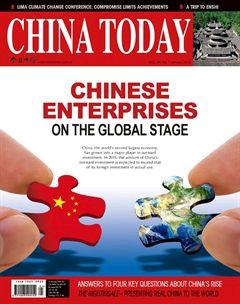Symbiotic Development
Chinas 30 or more consecutive years of express economic development have made it the worlds second largest economy. Growing pressure to sustain economic growth has led to the countrys new policy of innovation and opening-up. It will generate sufficient economic momentum to take China to the medium and high end of the industry chain, and at the same time create new opportunities for the world economy.
But this is no easy feat. A recent World Bank study shows that in the past 60 years, only 13 out of 88 medium-income economies have progressed to become high income countries. China is one such country going through this difficult transition.
The Central Economic Work Conference on December 9-11, 2014, convened in Beijing, submitted that Chinas economy has gradually entered a “new normal.” This is manifest in a medium-to-high rather than high growth rate, a development mode whose focus is on quality and high efficiency, an economic structure whose emphasis has shifted from adjusting current stocks to optimizing increments to promote further development, and the appearance of a new growth impetus. This “new normal” forecasts the economic characteristics of 2015 and also gives a general idea about Chinas economy over the next six years.
At present, start-ups in China are mostly in either the talent and technology-intensive fields of information transmission software and information technology services, or scientific research and technical services. Statistics show that in the first three quarters of 2014, growth in the former reached 98.5 percent, and that of the latter stood at 71.4 percent. Moreover various booming industries, including mobile Internet and health care, have shown ascending momentum. In the first 11 months of 2014, all types of venture capital institutions strategically allocated RMB 100 billion to technology and talent-intensive industries, such as mobile Internet, e-commerce, health care, and financial services. The country will also promote the pilot mode of Zhongguancun Science Park on a broader scale, and accelerate construction of national innovation demonstration zones to encourage grassroots innovation and entrepreneurship. Data show that in the first three quarters of 2014, Chinas high-tech industries achieved growth of 12.3 percent, and that its equipment manufacturing showed growth of 11.1 percent – significantly higher than the industry average.
At the same time industry began to move towards high end, the service industry became the largest source of economic growth. Consumption, too, has steadily contributed to economic growth, surpassing investment in this respect. The Central Economic Work Conference made the specific point that Chinas consumption had progressed from the imitative to the personalized mode. The potential market constituted by Chinas 1.3 billion people will undoubtedly provide strong backup for Chinas future medium-to-high growth.endprint
Domestic economic development has encouraged growing numbers of enterprises to go global. Chinas outbound foreign investment is now overtaking its utilization of foreign capital, which has transformed the pattern of its international economic cooperation from commodity-tradecentered to one dominated by capital and technology. These overseas Chinese enterprises have also promoted local industry, employment and living standards in their host countries.
The first regular China-Spain freight train from Yiwu, Zhejiang Province, to Madrid, the Spanish capital, went into service on December 9, 2014. Seven scheduled trains now leave Asia for Europe each day, including one from Chengdu, capital city of Sichuan Province, to Warsaw, Polands capital, and one from Chongqing Municipality to Berlin. As the Belt and Road (the Silk Road Economic Belt and the 21st Century Maritime Silk Road) Initiatives gradually advance, this even bigger market, covering two continents and more than 60 percent of the worlds population, is bound to benefit more countries, by virtue of their sharing the fruits of Chinas economic development. China has accordingly set up the Silk Road Fund and spent US $40 billion on establishing the Asian Infrastructure Investment Bank. Meanwhile negotiations to upgrade the Sino-ASEAN Free Trade Area and to construct the Sino-Sri Lankan Free Trade Area, the Sino-Belarusian Industrial Park, and the Sino-Pakistani Ruyi Textile Industry Park are all in process.
Experts believe that the Belt and Road Initiatives, conceived on the basis of Chinas efforts towards cooperation with external economies, signify the transition of its system of economic growth to one of regional growth.endprint

